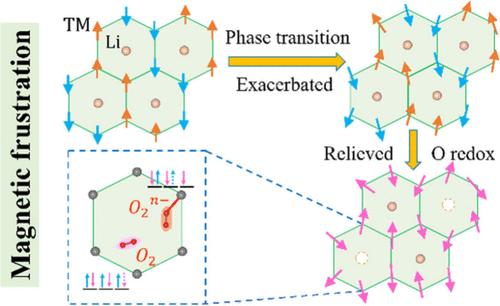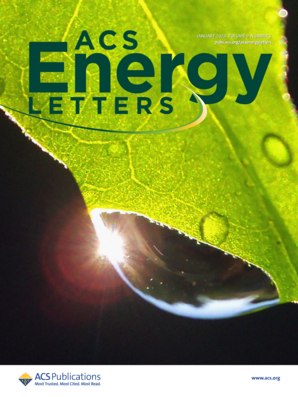富锂层状阴极中氧二聚体与强磁阻O2的耦合
IF 19.3
1区 材料科学
Q1 CHEMISTRY, PHYSICAL
引用次数: 0
摘要
在层状富锂阴极中阴离子氧化还原提供了高容量,但引发了一系列级联问题。目前的研究主要集中在氧如何参与氧化还原和过渡金属如何移动,往往忽略了磁阻的影响。本研究系统地探讨了蜂窝Li2RuO3中磁阻演化、结构演化和氧氧化还原之间的潜在联系。我们的研究结果表明,从C2/c到R3的相变加剧了Ru氧化过程中的磁挫败。随后,在氧氧化过程中,强烈的磁阻驱动(O2)n -的生成和捕获O2,从而减轻并最终消除磁阻。这种(O2)n−/O2的形成机制被称为“磁挫折驱动机制”,为具有强共价TM-O键的体系中捕获O2的形成提供了一个合理的解释。因此,我们强调改进策略不仅要增强共价TM-O键,而且要减轻强磁挫折。本文章由计算机程序翻译,如有差异,请以英文原文为准。

Coupling of Oxygen Dimer and Trapped O2 with Strong Magnetic Frustration in Layered Li-rich Cathodes
Anion redox in layered Li-rich cathodes provides a high capacity but triggers a series of cascading issues. Current research predominantly focuses on how oxygen species participate in redox and how transition metals move, often ignoring the influence of magnetic frustration. This work systematically investigates the potential link between the evolution of magnetic frustration, structural evolution and oxygen redox in honeycomb Li2RuO3. Our findings indicate that the phase transition from C2/c to R3 exacerbates the magnetic frustration during Ru oxidation. Subsequently, during oxygen oxidation, the strong magnetic frustration drives the generation of (O2)n− and trapped O2, which serves to relieve and eventually eliminate the magnetic frustration. This (O2)n−/O2 formation mechanism, termed “magnetic-frustration-driven mechanism”, provides a plausible explanation for the formation of trapped O2 in the systems with strong covalent TM–O bonds. Accordingly, we emphasize that improvement strategies should not only enhance the covalent TM–O bonds but also relieve strong magnetic frustration.
求助全文
通过发布文献求助,成功后即可免费获取论文全文。
去求助
来源期刊

ACS Energy Letters
Energy-Renewable Energy, Sustainability and the Environment
CiteScore
31.20
自引率
5.00%
发文量
469
审稿时长
1 months
期刊介绍:
ACS Energy Letters is a monthly journal that publishes papers reporting new scientific advances in energy research. The journal focuses on topics that are of interest to scientists working in the fundamental and applied sciences. Rapid publication is a central criterion for acceptance, and the journal is known for its quick publication times, with an average of 4-6 weeks from submission to web publication in As Soon As Publishable format.
ACS Energy Letters is ranked as the number one journal in the Web of Science Electrochemistry category. It also ranks within the top 10 journals for Physical Chemistry, Energy & Fuels, and Nanoscience & Nanotechnology.
The journal offers several types of articles, including Letters, Energy Express, Perspectives, Reviews, Editorials, Viewpoints and Energy Focus. Additionally, authors have the option to submit videos that summarize or support the information presented in a Perspective or Review article, which can be highlighted on the journal's website. ACS Energy Letters is abstracted and indexed in Chemical Abstracts Service/SciFinder, EBSCO-summon, PubMed, Web of Science, Scopus and Portico.
 求助内容:
求助内容: 应助结果提醒方式:
应助结果提醒方式:


